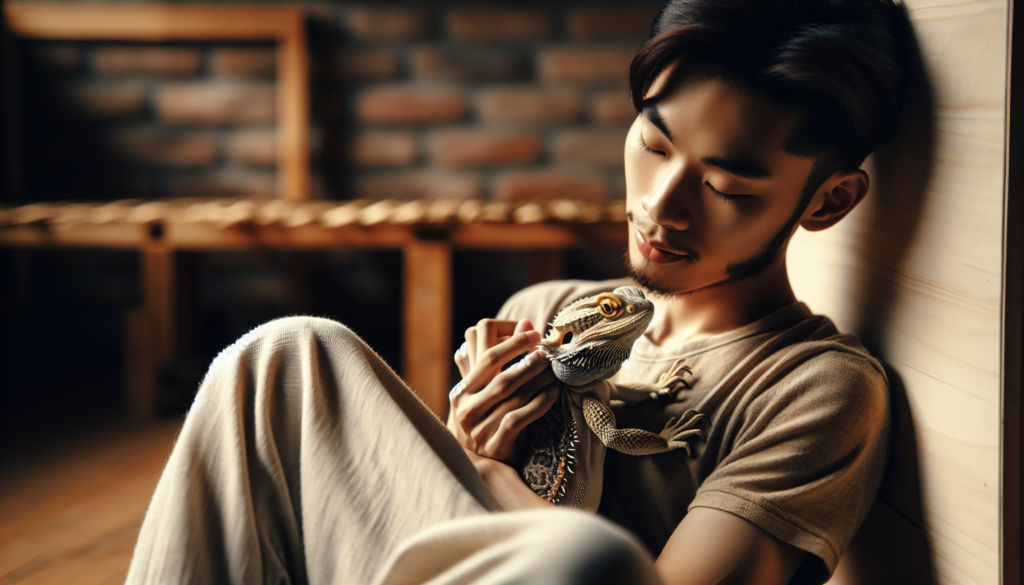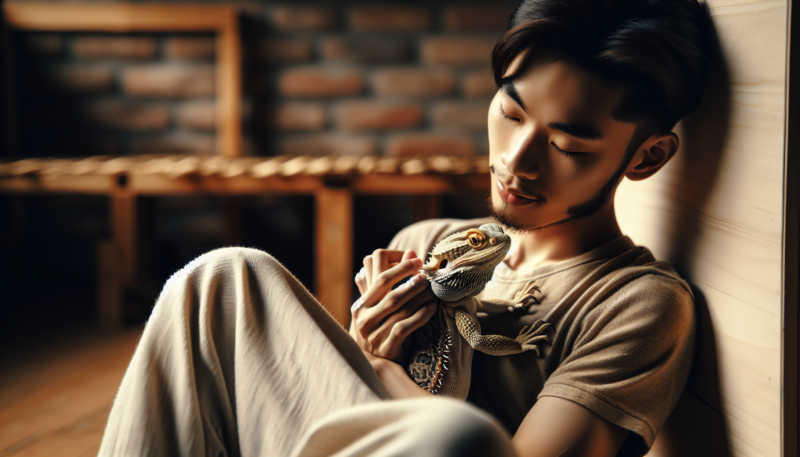Imagine the joy of snuggling up on the couch, feeling the warmth of a soft, scaly creature against your skin. But wait, can bearded dragons really cuddle with humans? This intriguing question has sparked curiosity among reptile enthusiasts and pet owners alike. In this article, we’ll explore the fascinating world of bearded dragons and their potential for cuddling with their human companions. So, get ready to uncover the truth behind this cuddly reptile mystery and discover the unique bond that can form between these radiant creatures and their adoring human friends.
Physical Interaction with Humans
Approachability of Bearded Dragons
Bearded Dragons are generally known for their friendly and docile nature, which makes them highly approachable pets. Unlike some other reptiles, they are not typically aggressive and can be easily tamed. Bearded Dragons have a curious and sociable personality, making them more likely to enjoy interacting with humans. However, it’s important to remember that each Bearded Dragon has its own unique temperament, so it’s essential to approach them with respect and caution.
Handling and Petting Bearded Dragons
Handling and petting your Bearded Dragon can be a delightful experience for both of you. When picking up your pet, approach them from the front, avoiding any sudden movements that may startle them. Gently scoop them up using both hands, supporting their body and legs properly. Bearded Dragons have delicate limbs that can be injured if handled improperly. Once you have them in your hands, hold them securely but gently, ensuring they feel safe and comfortable.
As you begin petting your Bearded Dragon, observe their body language for signs of pleasure or discomfort. Slowly stroke their head, neck, and back with a light touch using your fingertips. Some Bearded Dragons enjoy gentle scratching under their chin or around their ears. However, it’s important to be mindful of their personal preferences and respond accordingly. If they show signs of discomfort, such as moving away or puffing up their beard, give them space and try again later.
Bearded Dragons’ Tolerance for Physical Contact
While Bearded Dragons can be surprisingly tolerant of physical contact, it’s essential to respect their boundaries. Some individuals may enjoy being held and cuddled for extended periods, while others may prefer shorter interactions or simply being near their human companions. It’s crucial to pay attention to your Bearded Dragon’s body language and cues to understand their comfort level with physical contact.
Bearded Dragons, like many other reptiles, do not have the same wiring in their brains as mammals. They don’t have the capacity to feel emotions like love or cuddling in the way that humans do. However, they can still form a bond with their human caretakers and enjoy the mutually beneficial aspects of physical interaction. It’s important to remember that for Bearded Dragons, physical contact is more about warmth, security, and a sense of companionship.
Comfort and Body Language
Signs of Comfort in Bearded Dragons
Understanding the signs of comfort in Bearded Dragons can help you gauge their willingness to engage in physical interaction. Some common signs of a comfortable and happy Bearded Dragon include relaxed body posture, smooth and unfluffed beard, and a calm and steady demeanor. When comfortable, they may also show trust by closing their eyes or even falling asleep while in contact with their human companion.
Other signs of comfort can include a slow and gentle head bobbing, a relaxed tail, and a willingness to explore their surroundings while being held or petted. By paying close attention to these subtle cues, you can ensure that your Bearded Dragon is enjoying the physical interaction and feels at ease in your presence.
Evaluating Bearded Dragons’ Body Language
Bearded Dragons communicate through their body language, and understanding these signals can greatly enhance your ability to interact with them effectively. When evaluating your Bearded Dragon’s body language, pay attention to their posture, eye movements, and the position of their limbs.
For example, a Bearded Dragon that feels threatened or uncomfortable may exhibit defensive behaviors such as hissing, puffing up their beard, or opening their mouth wide. They may also flatten their body, raise their tail, or turn away from you. On the other hand, a relaxed and comfortable Bearded Dragon will have a more alert and gently curious expression, with their body and limbs positioned comfortably.
It’s crucial to respect your Bearded Dragon’s body language and provide them with the space and freedom to communicate their comfort levels. This way, you can ensure that your physical interaction remains enjoyable and stress-free for both of you.

Bonding and Social Behavior
Bonding Between Bearded Dragons and Humans
Contrary to popular belief, Bearded Dragons can indeed form bonds with their human caregivers. Bonding is a gradual process that requires time, patience, and consistent positive interactions. By regularly handling, petting, and feeding your Bearded Dragon, you can establish trust and create a foundation for a strong and lasting bond.
The bonding process is not only beneficial for the human counterpart but also for the Bearded Dragon. By bonding with their caregivers, Bearded Dragons can experience a sense of security, contentment, and overall well-being. It’s important to remember that the bond between a Bearded Dragon and a human is not based on emotional attachment in the same way it is between humans, but rather on a mutual understanding and positive association.
Bearded Dragons’ Recognition of Familiar Humans
Bearded Dragons have the ability to recognize familiar humans, as they can recognize consistent patterns and routines. By regularly spending time with your Bearded Dragon and engaging in positive interactions, you can establish yourself as a trusted and familiar presence in their life.
Remember that Bearded Dragons have excellent visual memory, so they can remember your face and associate it with positive experiences. This recognition may manifest in their behavior, such as approaching you willingly, responding to your voice, or even showing signs of excitement when you enter the room. However, it’s important to note that this recognition may not be the same as the emotional connection humans experience. Bearded Dragons primarily rely on visual and sensory cues rather than emotional attachment.
Temperature and Environment
Bearded Dragons’ Preference for Warmth
Bearded Dragons are ectothermic reptiles, meaning they rely on external sources of heat to regulate their body temperature. Their natural habitat consists of arid regions with high temperatures, so it’s crucial to provide them with an environment that mimics these conditions.
Maintaining the appropriate temperature gradient in their enclosure is vital, as Bearded Dragons require an optimal basking spot to thermoregulate. A basking spot with a temperature ranging from 95°F to 110°F (35°C to 43°C) allows them to absorb heat and properly digest their food. It’s important to ensure that the rest of the enclosure provides a gradient, allowing Bearded Dragons to choose their desired temperature zone.
Providing a Comfortable Environment for Cuddling
Creating a comfortable environment for cuddling with your Bearded Dragon starts with providing them with a suitable enclosure that meets their physical and psychological needs. The enclosure should have ample space for them to move around, adequate hiding spots, and a variety of environmental enrichments such as branches and rocks for climbing.
To ensure optimal comfort for cuddling, maintain a consistent and appropriate temperature throughout the enclosure. Additionally, provide a warm and cozy spot where your Bearded Dragon can relax and feel secure during cuddle sessions. A soft blanket or towel in a spot away from high traffic areas and potential distractions can make them feel at ease.
Be sure to allow your Bearded Dragon to choose whether they want to engage in physical contact or simply enjoy their own space. It’s essential to monitor their body language and respect their boundaries to maintain a comfortable and stress-free cuddling experience.

Natural Behavior of Bearded Dragons
Understanding Bearded Dragons’ Natural Behavior
To better understand Bearded Dragons’ comfort levels with physical contact, it’s important to have a basic understanding of their natural behavior in the wild. Bearded Dragons are solitary creatures, meaning they typically prefer their own company rather than forming social groups. They spend much of their time basking and foraging for food.
Bearded Dragons don’t naturally seek out physical contact with other individuals, including humans. Their interactions with others are primarily centered around establishing territories, mating, and occasionally defending themselves when threatened. Bearded Dragons’ natural behavior reflects their instinctual need for personal space and limited physical contact.
Contrast Between Bearded Dragons and Social Pets
Bearded Dragons’ natural behavior differs significantly from that of social pets like dogs or cats. Dogs, for example, have undergone centuries of domestication, resulting in a strong inclination towards bonding with humans and seeking physical contact. Cats, while more independent by nature, can still form strong emotional attachments to their human companions.
The contrast in natural behavior highlights the importance of understanding and respecting the inherent differences between species. While Bearded Dragons can develop a bond with their human caretakers, their comfort and willingness to engage in physical contact may not match the same level as social pets like dogs or cats. It’s crucial to always prioritize the well-being and comfort of your Bearded Dragon and adapt your expectations accordingly.
Limitations on Cuddling with Bearded Dragons
Risk of Injury or Discomfort for Bearded Dragons
Cuddling with Bearded Dragons, while enjoyable for many pet owners, can pose risks and discomfort for the reptiles themselves. Bearded Dragons have delicate limbs that can easily be injured if mishandled or dropped. It’s important to handle them with care and ensure a secure grip to minimize the risk of accidental harm.
Additionally, excessive cuddling or forcing physical contact can cause stress and discomfort for Bearded Dragons. They may interpret prolonged cuddling as overstimulation or a threat, leading to defensive behaviors like biting, scratching, or trying to escape. It’s essential to observe their body language and respect their cues to maintain a positive and stress-free cuddling experience.
Avoiding Overstimulation or Stress
While Bearded Dragons may enjoy moderate physical interaction, it’s important to avoid overstimulation. Bearded Dragons, as prey animals, are naturally cautious and can easily become overwhelmed or stressed. Keep cuddling sessions short and infrequent, gradually increasing the duration based on your Bearded Dragon’s comfort level.
It’s also important to create a calm and quiet environment during cuddling sessions. Loud noises, sudden movements, or crowded spaces can cause stress for Bearded Dragons and disrupt their sense of security.
Always prioritize your Bearded Dragon’s well-being and ensure that cuddling remains a positive experience for both of you. If your Bearded Dragon consistently shows signs of discomfort or stress during cuddling, it may be best to explore alternative forms of bonding that better align with their natural behavior and comfort level.
Alternative Forms of Bonding
Non-Physical Ways to Bond with Bearded Dragons
While physical contact can be enjoyable for both you and your Bearded Dragon, it’s not the only way to bond with them. Bearded Dragons are intelligent creatures that can form connections through various non-physical interactions. These can include:
-
Regular feeding and mealtime interactions: Bearded Dragons quickly learn to associate their human caretakers with a reliable food source. Feeding them at consistent times and engaging in interactive feeding sessions can help strengthen the bond.
-
Enrichment activities: Bearded Dragons benefit from mental stimulation and environmental enrichment. Providing them with toys, puzzles, and different scents can engage their curiosity and create opportunities for interaction.
-
Quiet observation: Spending time near your Bearded Dragon’s enclosure and observing their natural behaviors can help foster a sense of trust and familiarity. You can talk softly or read aloud to them, allowing them to become accustomed to your presence and voice.
-
Respectful socialization: Bearded Dragons may not naturally seek out physical contact, but they can still appreciate having their presence acknowledged. By sitting near their enclosure, talking to them gently, and occasionally offering a hand for them to investigate, you can establish a sense of companionship and mutual trust.
Creating a Mutual Trust and Connection
Building trust and a mutual bond with your Bearded Dragon requires patience, consistency, and positive reinforcement. Bearded Dragons can sense and respond to your energy, so it’s important to approach interactions with calmness and respect. By consistently providing a safe and comfortable environment and engaging in positive interactions, you can create a solid foundation for a meaningful connection.
Offering your Bearded Dragon a balanced diet, proper hydration, and regular veterinary care can also contribute to their overall well-being and trust in you as their caregiver. Remember that trust and bonding take time, and every Bearded Dragon is unique in their preferences and comfort levels.
Factors Affecting Bearded Dragons’ Comfort with Cuddling
Bearded Dragons’ Personality and Individual Differences
As with any living creature, Bearded Dragons have their own unique personalities and individual preferences. Some Bearded Dragons may naturally enjoy physical contact and cuddling, while others may prefer limited physical interaction. Factors such as genetics, upbringing, and personal experiences can influence their comfort levels with cuddling.
It’s important to treat each Bearded Dragon as an individual and respect their boundaries when it comes to physical contact. Some Bearded Dragons may become more comfortable with cuddling over time, while others may never fully enjoy prolonged physical interactions. Being attentive to their body language and cues can help you navigate their comfort levels and adapt your interactions accordingly.
Previous Experience and Socialization
The early experiences Bearded Dragons have with human interaction, handling, and socialization can shape their comfort levels with cuddling. Bearded Dragons that have had positive and gentle interactions during their early development stages may be more likely to enjoy physical contact as adults. On the other hand, Bearded Dragons that have had negative experiences or limited exposure to human interaction may be more cautious or reluctant to engage in cuddling.
If you have recently adopted a Bearded Dragon or are introducing physical contact for the first time, take it slow and allow them to acclimate at their own pace. Offering them enticing treats and positive reinforcement during interaction can help create positive associations and build their comfort and trust over time.
Building Trust and Mutual Bond with Bearded Dragons
Patience and Consistency in Handling Bearded Dragons
Building trust and a mutual bond with your Bearded Dragon requires patience, consistency, and gentle handling. It’s important to approach handling sessions with a calm and reassuring demeanor. Bearded Dragons are sensitive to their environment, so creating a quiet and stress-free atmosphere can help them feel more secure during interactions.
Consistency is key when handling Bearded Dragons. Regularly engaging in short, positive handling sessions can help them become desensitized to the experience and build trust over time. Using a gentle touch and gradually increasing the duration of each session can help them become more comfortable and at ease in your presence.
Positive Reinforcement and Rewards
Positive reinforcement is a powerful tool when it comes to building trust and a bond with your Bearded Dragon. Rewarding them with their favorite treats or verbal praise when they exhibit desirable behavior during handling sessions can help create positive associations.
It’s important to note that Bearded Dragons have different preferences when it comes to treats, so it may take some trial and error to find the ones they respond to most. Offering treats in small, appropriate quantities and ensuring they are nutritionally suitable for Bearded Dragons is essential for their health and well-being.
By consistently providing positive reinforcement, you can reinforce their trust in you and create an enjoyable and rewarding experience for both you and your Bearded Dragon.
Conclusion
Bearded Dragons, known for their friendly and docile nature, can form bonds with their human caregivers through physical interaction. While each Bearded Dragon has its own comfort level with cuddling, it’s important to approach physical contact with respect and sensitivity to their needs. By understanding their body language, creating a comfortable environment, and utilizing alternative forms of bonding, you can build trust and a mutual bond with your Bearded Dragon. Remember to always prioritize their well-being and adapt your interactions to their personal preferences. With patience, consistency, and positive reinforcement, you can create a meaningful and enjoyable relationship with your Bearded Dragon.
